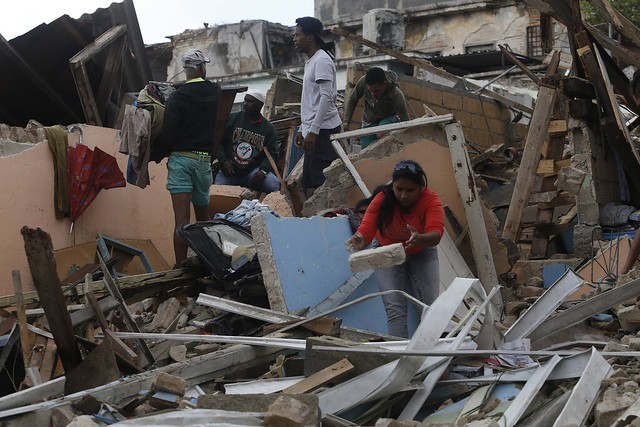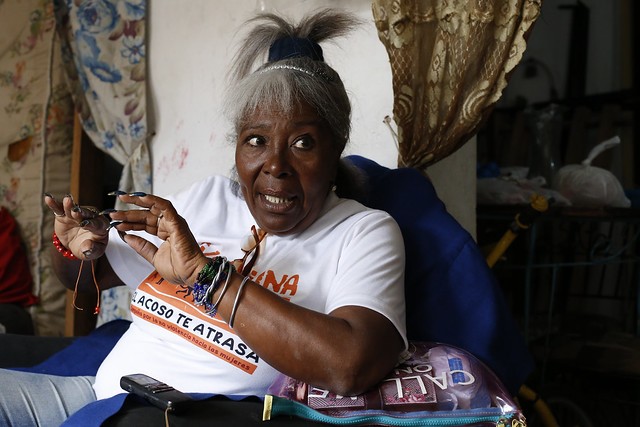Women’s Invisible Efforts to Recover Cuban Communities
By Ivet Gonzalez (IPS)

HAVANA TIMES – Workers enter and leave the long corridor where retired Mercedes Laferte, who they call “La Nina”, lives. She watched as her apartment in the Luyano neighborhood fell to pieces on January 27th, when a tornado swept through five of the Cuban capital’s municipalities.
Laferte’s rebuilt apartment only needs a few finishing touches, and the apartment above needs finishing too, which both collapsed in the small residential building when the tornado traveled 20 kilometers and hit a third of Havana’s municipalities, almost 11 months ago.
Women whose homes withstood the buffeting, make food every day for the brigade that is rebuilding in the area and doing other work, which tends to remain invisible in long-term recovery efforts after a natural disaster.
“We only returned to the apartment very recently,” Laferte told IPS, in reference to one of the 7872 homes that were damaged in the municipalities of Guanabacoa, Regla, San Miguel del Padron, Habana del Este and Diez de Octubre, which the Luyano neighborhood belongs to. In October, government authorities stated that they had already repaired 99.4% of damaged residences.
“We stayed at different neighbors’ homes from January until October, they have helped us a lot,” the victim said about what evacuation and recovery post-disaster mean in this Caribbean country with its economy in crisis, and where its 11.2 million inhabitants are falling more and more victim to extreme climatic events, such as hurricanes and drought.
Cuba is facing the global challenge of strengthening its response to natural disasters with inclusive focuses, such as gender and disability, and projects have been launched with international cooperation support in recent years, which range from training to adapting evacuation tools.

An extremely important issue, the disadvantages women suffer and their key role in tackling the effects of global warming fleshed out debates and civil complaints at the 25th United Nations Climate Change Conference (COP25), which was held in Madrid between December 2nd-14th.
“The effects of disasters are unequal because societies are still unequal and not every group has the condition to recover in the same way… the effects are felt according to the kinds of lives these people live,” sociologist Reina Fleitas explained to IPS. “The loss of a home has a very peculiar meaning for a woman… it’s very intense,” she specified.
In order to understand the inequalities that persist in spite of progress made, the expert recommends we focus on those who end up having to do the domestic and unpaid work, the different ways disrupted water and sanitation services affect women, as well as pay gaps and quality of housing, etc.
According to the latest data available in 2016, women aged between 15-74 years who work looking after the home, represent an average of 27.7% of the total. And women generally dedicate 14 hours more per week than men to domestic chores and looking after people in need or dependents, such as children and the sick.
“These reasons require that disaster risk policies include a gender perspective, because solutions to the problems that result from disasters have to relate to the different damages and capacities people create to get back on their feet,” Fleitas put forward.
Vilma Noa still has to walk up and down battered streets, where humble abodes stand side by side with renovated homes and others that are still being rebuilt, to see women affected in the neighborhood for the Federation of Cuban Women.
“Out of all the people who were evacuated from family residences, we only have to find a place for two single mothers with their children,” noted Noa, a disasters prevention and support technician, who also checks on 33 families who are staying at state-run shelters in the neighborhood, in one of the municipalities that was hit the worse by the natural phenomenon.
Women’s contributions and their disadvantaged position still aren’t reflected in public statistics about civic engagement in disaster recovery.
After the F4 category (6 being the highest on the Fujita scale) tornado swept through the capital, a total of 9916 people were evacuated, 1045 of whom were evacuated to state institutions and 8871 to family and friends’ homes, which don’t generally factor in gender. It still isn’t known how many people are still in this situation.
“Two state-run shelters were prepared for families whose homes were completely destroyed and had nowhere else to go. The rest were emergency evacuations,” Noa explained. “However, the population as it was understood is still learning to do things for themselves, from evacuation to rebuilding themselves,” she said.
Ever since 2010, government authorities have prioritized self-evacuation because of economic reasons, a more sustainable practice, where the community and women’s contribution are clear.

Available statistics from the last hurricanes to hit Cuba show that in 2017, 86% of 1,738,000 evacuated people did so in neighbors, friends or relatives’ homes after the impact of Irma, which skirted Cuba’s northern coast. In response to Hurricane Matthew in 2016, self-evacuation before the impact covered 93% of protected people.
“You never know when another disaster like this can strike: you need to be prepared for all of these problems,” victim Laferte weighed in, who already enjoys basic living conditions in her new home with her son.
“The State organizes a series of things but mass (social) organizations and volunteers are becoming more and more involved in providing aid,” she said.
With the door open to her apartment, retired Barbara Gravera talks to her friend La Nina, who stayed with her son in a neighbor’s home, while many other women in the building stored and cooked her food.
“We have supported her up until now… we continue to help because I cook for the brigade of builders,” Graveran explained.
With tears falling as she remembered the hard times, the domestic worker Miriam Hernandez said that “everyone has helped La Nina, not just me.” “I had heard a lot about people in other provinces coming together and helping neighbors who were left homeless by the hurricanes and I decided to do the same,” she said.
“Cuban women are a lot stronger than men: they come through a great deal [in emergencies],” Noa said. “But you have to bear in mind that there are other problems that affect women: damages to their psychological health or whether they don’t have a job. I myself need more training in order to better help them,” she continued.
Noa confirmed the vulnerable situation of elderly women, who have been victims of poor repairs and builders not keeping up their end of the deal. Never-ending leaks in roofs, bathrooms and kitchens, retired Iluminada Hernandez complains, who lives with her son who has an mental disability.
Noa was among the local decision-makers and female victims from Diez de Octubre and Guanabacoa who benefited from workshops providing psychological help, which the NGO “Centro Oscar Arnulfo Romero” organized as part of the “Habana resiliente” project. For a safer and more inclusive city.
The project runs unusual workshops and other gender-focused community actions for 2000 families, funded by the Directorate-General for European Civil Protection and Humanitarian Aid Operations and endorsed by international NGOs CARE, Oxfam and Humanity & Inclusion.

I don’t wish natural disasters on nobody. Life itself is tough enough.